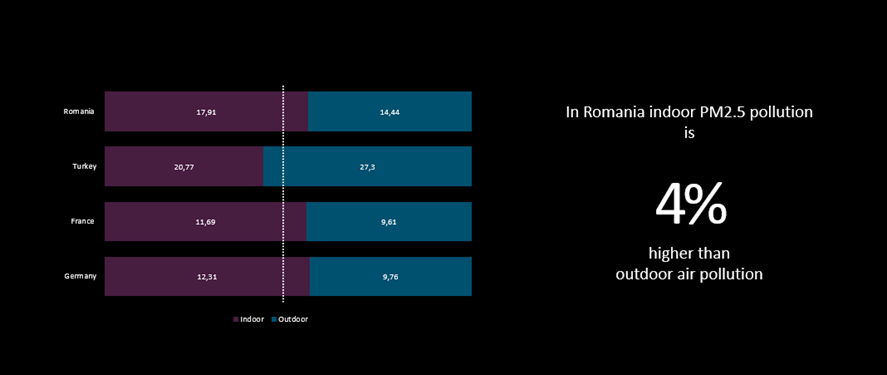Today, Dyson unveils the results of its first Global Connected Air Quality Data project, the largest study of indoor air quality globally. The project studies indoor air quality information collected by more than 2.5 million Dyson Purifiers from 2022 to 2023 to landscape air quality in real homes across the world, to a granularity never before seen.
Whilst data is based on homes with Dyson Purifiers and as such is not nationally representative, the volume of data reaches into the tens of billions of data points and paints a picture of indoor air quality in cities and countries globally beyond the scale that has been achievable to date.
From a wealth of data, this project focuses on two types of pollutant – PM2.5, and Volatile Organic Compounds (VOCs). PM2.5 refers to particles as small as 2.5 microns in diameter; a typical human hair measures around 70 microns in diameter. These particles are invisible to the naked eye, can be inhaled and are an area of increasing scientific and health research. Sources include combustion – wood burners, or gas cooking and heating – pollens, pet dander and dust. VOCs are gas pollutants including Benzene and Formaldehyde which can be emitted from activities like cleaning or cooking as well as from products including deodorants and body sprays, candles, furniture and furnishings.
“Our connected air quality data allows us insight into the real problem of indoor air pollution in homes across the world. This gives us a direct understanding of the challenges Dyson Purifiers face in real environments and the knowledge to engineer ever-better machines to tackle those challenges. But the data we capture isn’t just an engineering tool – on an individual basis, this data is shared back through the MyDyson app in real-time and via monthly reports, to help our Owners improve their air quality understanding.” – Matt Jennings, Engineering Director for Environmental Care
”We all think of air pollution as being an outdoor or roadside problem. Indoor air pollution research is growing but continues to be underdeveloped. Dyson’s findings give us a valuable insight into the real pollution levels in homes across the world, helping us to understand the patterns of pollution daily, monthly and seasonally. The Dyson data is an incredibly powerful education tool and the opportunities for positive impact are boundless – understanding the pollution around us is the first step to reducing our pollution exposure.” – Professor Hugh Montgomery, Chair of Intensive Care Medicine at University College London, and Chairperson of Dyson’s Scientific Advisory Board.
Romanian indoor air quality is lower than outdoor air quality
In most nations, interior air pollution is higher than outside air pollution, according to analyses of P.M2.5 (fine particulate matter) values. A number of adverse health effects have been associated with exposure to both PM2.5 and PM10. For PM2.5, short-term exposures (up to 24 hours) were associated with premature mortality, increased hospitalizations for cardiac or pulmonary causes, acute and chronic bronchitis, asthma attacks, emergency room visits, respiratory symptoms and restrictions, days of inactivity. These adverse health effects have been reported mainly in infants, children and older adults with pre-existing heart or lung disease. In Romania, air pollution is a serious problem, and the national and international authorities impose increasingly strict standards, in order to reduce the degree of air contamination. Ten months out of the year have more interior air pollution than outside air pollution in Romania, where indoor pollution is generally lower than outdoor pollution. May is considered to be the month where indoor pollution is highest, compared to outdoor pollution. Romania is the sixth country—above France, Germany, and the UK—that has indoor PM2.5 air quality that is above the WHO’s yearly norm. Turkey, which is rated third in EMEA, is the country with the lowest ranking.
 Pollution is strongest during the winter
Pollution is strongest during the winter
Winter is generally a time when individuals spend a lot more time inside the house. Whether it’s at work, home, or leisure, we spend ninety percent of the year indoors. Globally, the winter season is the most polluted, according to statistics from Dyson purifiers. With the windows closed and the possibility of using combustion-based heating methods like wood burners, gas heaters, or even candles, we tend to seal our homes more during the winter. But winter was not the month in every country that saw the highest level of pollution in any given year. When it comes to air pollution in Romania, November is the most polluted month. In January, March, and November–December, the national average data surpasses the WHO recommendation by four times, peaking at 3.5 times higher.
 Romania is the second most polluted country in Europe in PM2.5 annual average
Romania is the second most polluted country in Europe in PM2.5 annual average
When looking globally at the data from Dyson connected purifiers throughout 2022, there are some unexpected outcomes when ranking countries on their average PM2.5 level. Romania is the second most polluted country in Europe, ranking 6th place globally, after Turkey that ranks first place in Europe and 3th place from all analyzed countries. Italy is placed globally on 9th and Poland on 10th. Austria sits in 11th and Spain 14th. The UK (23rd) outranks the United States (27th), Canada (28th) and Australia (29th), but Germany and France rank higher, at 20th and 22nd. India and China occupy the top two spots, likely due to the relationship between indoor and outdoor air quality. Indoor PM.5 annual averages in all countries studied exceeded the WHO annual guideline for PM2.5 (5 µg/m3) – India by 11 times, China by 6 times, Turkey and UAE by 4 times, and South Korea, Romania, Mexico, Hong Kong SAR and Italy by 3 times. When the P.M 2.5 values of the countries are analyzed annually, Romania is among the 10 countries with the highest values together with India, China, UAE, South Korea, Turkey, Mexico, Hong Kong SAR, Italy, Poland and ranks 6th. It is also the second country with the highest P.M 2.5 value among European countries. Turkey is the first one with( 3rd) followed by Italy (9th) and Spain (14th) in Europe.
Romania is one of the nations with the highest VOC concentrations
According to Dyson Purifiers, European nations had the highest yearly VOC (volatile organic compounds) levels in contrast to PM2.5. Volatile organic compounds are irritating substances, present in the breathable air, which pollute the air and can cause adverse reactions such as headaches, respiratory problems, allergic reactions, etc. Austria is at the top of the list, followed by Germany, Romania, Poland, Switzerland, and Turkey. Ireland is ranked tenth, Italy eighth. Numerous nations that scored highly on average for yearly PM2.5 also scored poorly on VOCs; the top half of nations by annual VOCs does not include Thailand, the United Arab Emirates, Taiwan, Malaysia, Hong Kong Special Administrative Region, or South Korea. In truth, Denmark, the US, France, and Spain are all ranked higher.
In the same time, European cities have higher indoor VOC concentrations than other locations. The cities that rate highest are Munich, Beijing, Cologne, Berlin, and Vienna. Beijing is the only city in the top five for annual PM2.5 and VOCs; other top ten cities for average levels of both pollutants include Mexico City, Delhi, Istanbul, Shanghai, and Istanbul.
Based on indoor VOC levels, Austria, Romania, Germany, Switzerland, Poland, Turkey, India, Italy, China, and Ireland rank in the top 10 European countries.
Evening pollution higher than any other time of day
Indoor PM2.5 levels peaked in 30 of the 37 nations where the study was conducted in the evening and night, when most people are at home instead of at work, school, or some other location. A major factor in the community studying air quality is exposure, which is the measurement of air pollution concentration over time. A spike in air pollution, or an extremely high level for a brief period of time, isn’t always worse than continuous exposure to “poor” or even “fair” air quality. Thus, the longer, more polluted period may be the cause of the increased exposure to PM2.5 in houses, according to data from Dyson Purifiers. In most regions, peak hours were from 6 p.m. until midnight, although in South East Asia (Thailand, Philippines, India) the most polluted hours fall between 7am and midday. South Korea and Mexico are two other key exceptions, seeing highest pollution levels between midnight and 7am, and 9am and 3pm respectively.
 Across a typical 24h period, several geographies spent more than 50% of the day above the World Health Organisation recommended daily exposure guideline for PM2.5 (15 µg/m3). Countries include China, India, South Korea, Mexico, UAE and Turkey. Berlin, Rome, Milan, Madrid and the national average in Poland and Romania all spent part of a typical day exceeding WHO guidelines for daily PM2.5 exposure. On the other hand, homes in Shanghai, Beijing, Shenzhen, Delhi, Mumbai, Vienna, Mexico City, Dubai and Istanbul all also spent more than 50% of a typical 24h period above WHO guidelines throughout 2022.
Across a typical 24h period, several geographies spent more than 50% of the day above the World Health Organisation recommended daily exposure guideline for PM2.5 (15 µg/m3). Countries include China, India, South Korea, Mexico, UAE and Turkey. Berlin, Rome, Milan, Madrid and the national average in Poland and Romania all spent part of a typical day exceeding WHO guidelines for daily PM2.5 exposure. On the other hand, homes in Shanghai, Beijing, Shenzhen, Delhi, Mumbai, Vienna, Mexico City, Dubai and Istanbul all also spent more than 50% of a typical 24h period above WHO guidelines throughout 2022.
Limited worldwide use of Dyson Purifiers Auto mode
It appears that Dyson machines in homes around the world are not being used to automatically manage the pollution events in homes these connected air quality data insights show, as only 8% of Dyson purifiers worldwide spend more than three-quarters of their time in Auto mode, where the machine continuously monitors the air quality and automatically reacts to changing pollution levels. With 14% of purifiers in Auto mode, the US leads the world. Chicago is the most popular city, followed by New York, Toronto, and Los Angeles. The majority of users in Romania choose to operate their air purifiers manually, with very few using them in automatic mode.


































